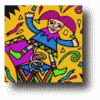error-correcting code
Can you encode a message so that errors in transmission are automatically corrected?
When you transmit information long-distance there is always a chance that some of it gets mangled and arrives at the other end corrupted. Luckily, there are clever ways of encoding information which ensure a tiny error rate, even when your communication channel is prone to errors.
Can you measure information? It's a tricky question — but people have tried and come up with very interesting ideas.
This is a game played between a team of 3 people (Ann, Bob and Chris, say), and a TV game show host. The team enters the room, and the host places a hat on each of their heads. Each hat is either red or blue at random (the host tosses a coin for each team-member to decide which colour of hat to give them). The players can see each others' hats, but no-one can see their own hat.
